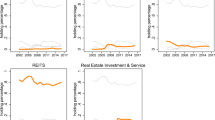Abstract
In this paper, we examine whether mutual fund managers in Taiwan produce superior performance through concentrated investment strategy, and find that mutual funds with higher degree of concentration have higher investment performance and lower risk during the period 2001–2009. Moreover, when the degree of industry concentration of fund holdings is higher, there is less impact on stock market performance. However, the premium of the market portfolio has more impact on the performance of funds when there is lower degree of industry concentration. We also find that the stock-picking and market-timing abilities of mutual fund managers result in funds with high degree of industry concentration having more returns and lower risks than the funds with low degree of industry concentration.
Similar content being viewed by others
References
Cardona J. C. (1998) The asset allocation decision. ABA Banking Journal 90: 94–95
Carhart M. (1997) On persistence in mutual fund performance. Journal of Finance 52: 57–82
Chan L. K. C., Chen H.-L., Lakonishok J. (2002) On mutual fund investment styles. Review of Financial Studies 15: 1407–1437
Chan K. S. (1993) Consistency and limiting distribution of the least squares estimator of a continuous threshold autoregressive model. The Annals of Statistics 21: 520–533
Coval J. D., Moskowitz T. J. (1999) Home bias at home: Local equity preference in domestic portfolios. Journal of Finance 54: 2045–2074
Coval J. D., Moskowitz T. J. (2001) The geography of investment: Informed trading and asset prices. Journal of Political Economy 109: 811–841
Daniel K., Grinblatt M., Titman S., Wermers R. (1997) Measuring mutual fund performance with characteristic-based benchmarks. Journal of Finance 52: 1035–1058
De Wit D. P. M. (1998) Naïve diversification. Financial Analysts Journal 54: 95–100
Fama E. F. (1972) Components of investment performance. Journal of Finance 27: 551–567
Ferson W., Schadt R. (1996) Measuring fund strategy and performance in changing economic conditions. Journal of Finance 51: 425–462
Golec J. H. (1996) The effects of mutual fund managers’ characteristics on their portfolio performance, risk and fees. Financial Services Review 5: 133–147
Goetzmann W. N., Ibbotson R. G. (1994) Do Winners Repeat?. Journal of Portfolio Management 20: 9–18
Grinblatt M., Titman S. (1989) Portfolio performance evaluation: Old issues and new insights. Review of Financial Studies 2: 393–421
Grinblatt M., Titman S. (1992) The persistence of mutual fund performance. Journal of Finance 47(5): 1977–1984
Grinblatt M., Titman S., Wermers R. (1995) Momentum investment strategies, portfolio performance, and herding: A study of mutual fund behavior. American Economic Review 85: 1088–1105
Gruber M. (1996) Another puzzle: The growth in actively managed mutual funds. Journal of Finance 51: 783–807
Hansen B. E. (1999) Threshold effects in non-dynamic panels: Estimation, testing and inference. Journal of Econometrics 93: 345–368
Hansen B. E. (2000) Sample splitting and threshold estimation. Econometrica 68: 575–603
Henriksson R. D., Merton R. C. (1981) On market timing and investment performance II: Statistical procedures for evaluating forecasting skills. Journal of Business 54: 513–534
Hiraki T., Ito A., Kuroki F. (2003) Investor familiarity and home bias: Japanese evidence. Asia-Pacific Financial Markets 10: 281–300
Jensen M. C. (1968) The performance of mutual funds in the period 1945-64. Journal of Finance 23: 389–416
Kacperczyk M., Clemens S., Zheng L. (2005) On the industry concentration of actively managed equity mutual funds. Journal of Finance 60: 1983–2013
Khorana A. (1996) Top management turnover: An empirical investigation of mutual fund mangers. Journal of Financial Economic 40: 403–427
Lakonishok J., Shlieifer A., Thaler R., Vishny R. (1991) Window dressing by pension fund managers. American Economic Review 81: 227–239
Lehmann B. N., Modest D. M. (1987) Mutual fund performance evaluation: A comparison of benchmarks and benchmark comparisons. Journal of Finance 42: 233–265
Markowitz H. (1959) Portfolio selection: Efficient diversification of investments. Wiley, New York
Nanda V., Wang Z., Zheng L. (2004) Family values and the star phenomenon. Review of Financial Studies 17: 667–698
Otten R., Bams R. (2004) How to measure mutual fund performance: Economic versus statistical relevance. Accounting and Finance 44: 203–222
Sapp T., Yan X. (2008) Security concentration and active fund management: Do focused funds offer superior performance?. Financial Review 43: 27–49
Scharfstein D. S., Stein J. C. (1990) Herd behavior and investment. American Economic Review 80: 465–479
Shawky H. A., Smith D. M. (2005) Optimal number of stock holdings in mutual fund portfolios based on market performance. Financial Review 40: 481–495
Author information
Authors and Affiliations
Corresponding author
Rights and permissions
About this article
Cite this article
Chou, PI., Lee, CH. Is Concentration a Good Idea? Evidence from Active Fund Management. Asia-Pac Financ Markets 19, 23–41 (2012). https://doi.org/10.1007/s10690-011-9140-x
Published:
Issue Date:
DOI: https://doi.org/10.1007/s10690-011-9140-x




